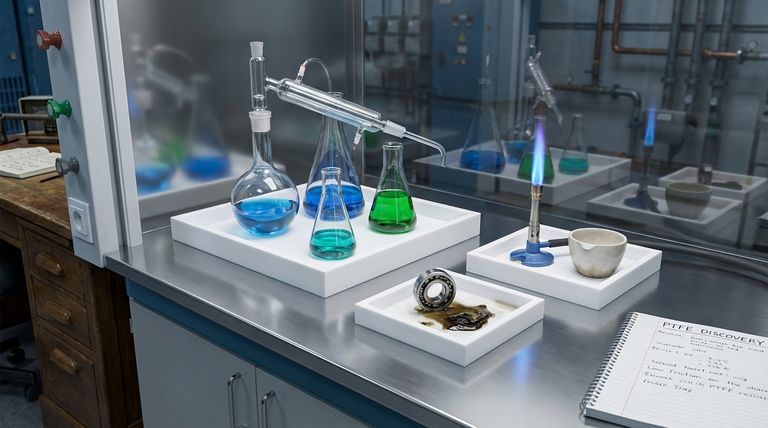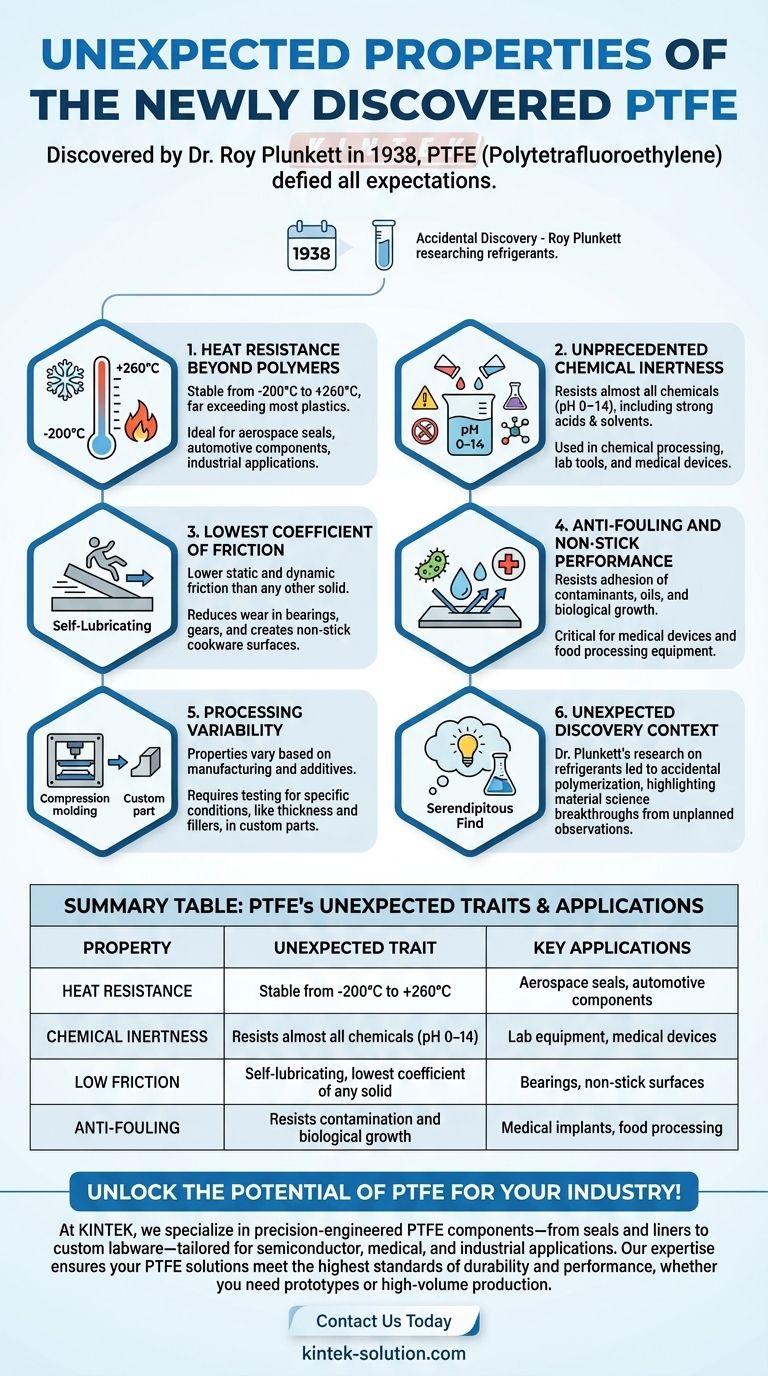When polytetrafluoroethylene (PTFE) was accidentally discovered by Dr. Roy Plunkett in 1938, its properties defied conventional expectations for polymers at the time. Initially, researchers anticipated it would behave like other known plastics, but PTFE demonstrated unparalleled heat resistance, near-universal chemical inertness, and the lowest coefficient of friction of any solid material. These traits emerged unexpectedly during early testing and fundamentally reshaped industrial applications—from non-stick cookware to aerospace components. The material’s stability across extreme temperatures (-200°C to +260°C) and corrosive environments made it indispensable in fields demanding reliability under harsh conditions. Its anti-fouling and self-lubricating properties further expanded its utility, though processing variables could alter performance, requiring careful evaluation for specific uses like custom PTFE parts.

Key Points Explained:
-
Heat Resistance Beyond Polymers
- PTFE remains stable from -200°C to +260°C, far exceeding the thermal limits of most plastics.
- This property was unexpected; most contemporary polymers degraded at high temperatures or became brittle in extreme cold.
- Applications: Used in aerospace, automotive, and industrial seals where temperature fluctuations are extreme.
-
Unprecedented Chemical Inertness
- Resists almost all chemicals, including strong acids, bases, and solvents (pH 0–14), except molten alkali metals and free fluorine.
- Unlike other materials, PTFE doesn’t react or degrade when exposed to corrosive substances.
- Why it matters: Ideal for chemical processing equipment, lab tools, and medical devices requiring biocompatibility (FDA/RoHS compliant).
-
Lowest Coefficient of Friction
- PTFE’s static and dynamic friction coefficients are lower than any other solid, giving it "self-lubricating" properties.
- This defied initial assumptions that plastics would exhibit higher friction under load.
- Practical impact: Reduces wear in moving parts (e.g., bearings, gears) and enables non-stick surfaces (cookware, conveyor belts).
-
Anti-Fouling and Non-Stick Performance
- Surfaces resist adhesion of contaminants, oils, and biological growth.
- Critical for: Medical devices (prevents bacterial adhesion) and food processing (easy cleaning).
-
Processing Variability
- Properties can vary based on manufacturing methods (e.g., compression molding vs. extrusion) and additives.
- Users must test custom PTFE parts for specific conditions, as thickness or filler materials may alter performance.
-
Unexpected Discovery Context
- Dr. Plunkett was researching refrigerants when PTFE’s polymerization accidentally occurred.
- The serendipitous find highlights how material science breakthroughs often arise from unplanned observations.
PTFE’s legacy lies in these surprises—transforming industries by solving problems traditional materials couldn’t address. Its discovery reminds us that innovation sometimes emerges from the unexpected.
Summary Table:
| Property | Unexpected Trait | Key Applications |
|---|---|---|
| Heat Resistance | Stable from -200°C to +260°C | Aerospace seals, automotive components |
| Chemical Inertness | Resists almost all chemicals (pH 0–14) | Lab equipment, medical devices |
| Low Friction | Self-lubricating, lowest coefficient of any solid | Bearings, non-stick surfaces |
| Anti-Fouling | Resists contamination and biological growth | Medical implants, food processing |
Unlock the potential of PTFE for your industry! At KINTEK, we specialize in precision-engineered PTFE components—from seals and liners to custom labware—tailored for semiconductor, medical, and industrial applications. Our expertise ensures your PTFE solutions meet the highest standards of durability and performance, whether you need prototypes or high-volume production. Contact us today to discuss how we can enhance your projects with PTFE’s unparalleled properties.
Visual Guide

Related Products
- Custom PTFE Square Trays for Industrial and Laboratory Use
- Custom PTFE Parts Manufacturer for Teflon Parts and PTFE Tweezers
- Custom PTFE Teflon Balls for Advanced Industrial Applications
- Custom PTFE Sealing Tapes for Industrial and High Tech Applications
- Custom PTFE Sleeves and Hollow Rods for Advanced Applications
People Also Ask
- What is the molecular structure of PTFE? The Key to Its Unmatched Chemical & Thermal Resistance
- How does PTFE react to common solvents? Discover Its Near-Total Chemical Immunity
- What are the different types of Teflon available? A Guide to PTFE, FEP, PFA, and More
- How does PTFE contribute to environmental benefits? Durability, Efficiency, and Contamination Prevention
- How was PTFE discovered and developed? From Lab Accident to Essential High-Performance Polymer



















